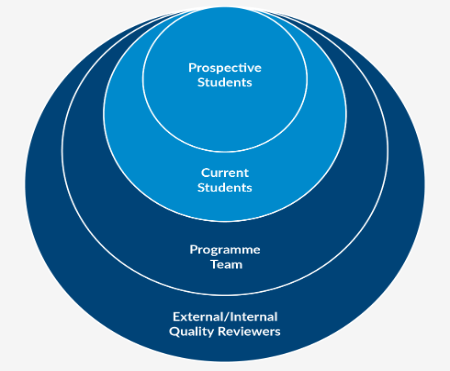Step 3 - Articulate
A key element to any strategy is that it is articulated to the key stakeholders. UCD Academic Regulations (2021-2022) highlight the importance of articulating, in a programme’s specification, the programme ‘assessment and feedback strategies’ (Reg 1.14i).

Figure 2: Programme Assessment and Feedback Strategy: Amount of Information for Different Audiences
Key Stakeholders
The key stakeholders can include prospective and current students, graduates, faculty, staff, professional bodies, employers, external and internal reviewers (QA/external examiners). The amount and type of information required for these different stakeholders will vary, depending on their familiarity with the programme and the judgements they are making based on this information (Figure 2).
These can be divided into four key stakeholder groups (or audiences) and some of the key aims, characteristics and information, required for these different stakeholders in relation to the programme assessment and feedback strategy are detailed in this resource on writing an assessment and feedback strategy.
Aims and Characteristics
Although there is not one way to write a programme assessment and feedback strategy, the following gives some aims and characteristics.
The aims of the assessment and feedback strategy statement for this cohort are that:
- Students are aware of any competencies required in the assessment
- Students are clear on the rationale for particular approaches they will experience
- It will assist students in module and or programme decision-making
The information should be communicated in an easily understood language and be relatively brief, for example, three to eight lines approximately. The information should highlight the:
- Purposes of assessment (for grading and feedback)
- Method of assessment and their rationale
- Balance: continuous and end of semester split
- Amount of assessment
- Types of feedback and their rationale
- Other relevant details: information on upcoming placements assessment
The aims of the assessment and feedback strategy statement for this cohort are that:
- Students are aware of any competencies required in the assessment
- Students are clear on the rationale for particular approaches they will experience
- It will assist students in module decision-making
- Students are informed of how the assessment and feedback develops throughout the programme
- Students are aware of the key assessment standards, criteria, in order to progress in their learning
- It helps supports students’ engagement in their assessment and feedback approaches
The information should be communicated in easily understood language and should be approximately a one to two narrative paragraph overview and include relevant tables and images. Faculty should, where possible, encourage students to be part of the articulation of and engagement with the assessment and feedback strategy process.
The information should highlight, for example:
- The purposes of assessment (for grading and feedback)
- The method of assessment and their rationale
- Balance of assessment: continuous and end of semester split
- Amount of assessment
- Types of feedback and their rationale
- Information on upcoming placements assessment
- How and when assessed (Timetable of assessment per semester and stage)
- The weighting of component parts
- How it will be graded (including any rubrics)
- Standards expected
- Who is grading (lecturer/tutor)
- Simple programme overview/map (using tables, graphics, etc) of assessment and feedback
- Purposes and types of feedback
- Student's role in feedback/self-regulating, including how to use feedback
Faculty and staff involved in the programme and stage delivery require similar information to that received by the students above. However, it is beneficial for staff to also share any additional information on:
- Assessment load
- Equivalence of weighting of assessments (typical word counts/student effort for common methods);
- Grading, rubrics, or marking schemes
Quality reviews/professional accreditations may require additional evidence of the impact of the assessment and feedback strategies used and evidence of monitoring of assessment and feedback approaches, i.e. programme meeting records and actions.